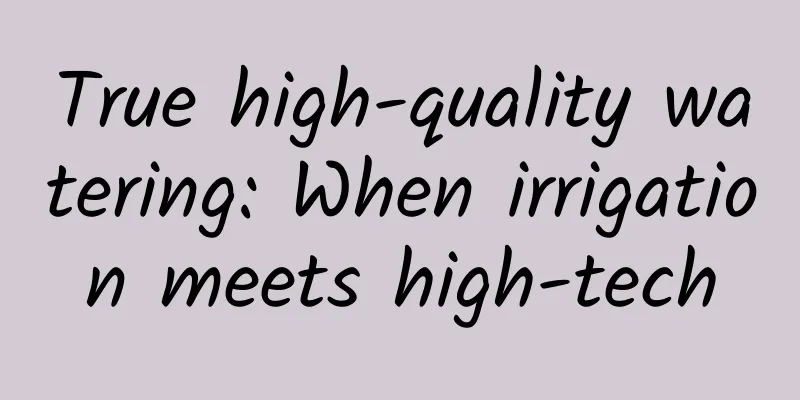True high-quality watering: When irrigation meets high-tech

|
In order to ensure the country's food security and promote rural revitalization and green development, the country is actively promoting the construction of high-standard farmland, efficient water-saving construction, and modernization and transformation of irrigation areas. The development of low-energy, high-quality, multi-functional, and easy-to-manage smart irrigation will be the future direction of the water-saving irrigation industry. Image source: Veer Gallery Although some projects have been built in various places for high-standard farmland, irrigation area transformation, and high-efficiency water-saving projects, the current development is extremely unbalanced. There are still problems such as unreasonable technical design, inadequate construction supervision, uneven quality of equipment used, and insufficient subsequent operation and maintenance costs. Therefore, it is necessary to standardize the automation and intelligence of the irrigation industry in terms of technology and equipment, so that enterprises and governments can work together for development. Irrigation industry technology develops towards automation and intelligence Scientists continue to innovate in technology, promoting the development of water-saving irrigation towards precision, automation and intelligence . For example, integrate signal transmission technology and control technology to create and improve irrigation decision-making control theory and technology; promote the development of intelligent water-saving irrigation technology models in different ecological types based on industries such as field crops such as grain, cotton, rapeseed, tea, and fruit trees, and facility horticultural crops such as vegetables, flowers, and edible fungi. Optimize key components such as the head, pipelines, filters, solenoid valves, water distributors, etc., apply engineering control technology and information management technology, carry out integrated innovation, form an intelligent irrigation technology system with multiple elements, and realize the intelligent and precise application of water, fertilizers, and medicines. In Xinxiang, Henan Province, the Institute of Farmland Irrigation of the Chinese Academy of Agricultural Sciences has developed an intelligent irrigation management cloud platform that organically integrates soil moisture sensors, water-fertilizer integrated machines, crop water and fertilizer requirement knowledge base, irrigation decision-making models, weather forecasts, GIS, video monitoring, agricultural records, data statistical analysis and visualization. Using efficient irrigation engineering technology, the platform realizes the whole process of water monitoring and intelligent water and fertilizer management from water source to field, from soil to crops. The platform has been applied in some tea gardens in Xinyang, Henan Province, and the automated irrigation project in Fuping County, Hebei Province. Intelligent irrigation and water-fertilizer integrated system (Photo credit: Produced by Cai Jiumao of the Irrigation Institute) The integration of multiple technologies promotes water-saving irrigation In addition to technological innovation, modern, efficient and water-saving irrigation requires special equipment for precision irrigation, as well as the application of new materials, new technologies, and new processes, the development of new equipment, or the resolution of technical bottlenecks. Water-saving irrigation equipment covers a wide range, including many general building materials and electromechanical equipment, as well as certain special equipment, which need to be developed based on market industry needs and overall technological progress. Multidisciplinary integration is an important method for creating these special equipment, such as creating a batch of high-performance and high-reliability signal acquisition equipment and terminal control equipment for water, soil, fertilizer, air, medicine and crops; combining new materials and new processes to improve the durability of rotating parts of sprinkler heads, the aging resistance of the elastic membrane of compensating sprinklers, and the reliability of precision control valves. It is also necessary to apply new technologies to improve the structure of long-flow emitters and solve the problem of silt deposition and blockage in pipes and emitters; use big data and information technology to develop integrated air-space-ground monitoring and forecasting technologies, create electronic equipment for real-time online monitoring of water and fertilizer concentrations, and precise irrigation and fertilization systems that couple water and fertilizer. Irrigation areas are the main battlefield for grain crop production in China and an important guarantee for ensuring food security. By utilizing advanced information technology and engineering technology, we can implement precise field irrigation in irrigation areas, precise measurement of canal systems, and optimized management of the entire water use process. We can build a smart water use decision-making service platform for irrigation areas and an evaluation index system for ecological irrigation area construction , which can enhance the benefits of water-saving irrigation projects in irrigation areas, improve the utilization efficiency of water resources in irrigation areas, and promote green and sustainable development of irrigation areas. Automatic water measurement facilities in Sandian Irrigation District, Yuzhong County, Gansu Province (Photo source: author) Multiple parties work together my country has a vast territory, and the natural and economic conditions vary greatly from place to place. There is an obvious trend of diversification in the categories and grades of water-saving irrigation equipment products. This diversified demand provides a broader development space for the material equipment industry. The development of water-saving irrigation is inseparable from technology and equipment, and even more so from the producers and managers behind it. Enterprises are currently becoming the main body of product and equipment creation, large-scale production, and water-saving irrigation project construction. Enterprises can combine the technical strength of universities and scientific research institutions to establish various social organizations such as associations, alliances, innovation centers, and R&D centers, and play an increasingly important role in the development of the water-saving irrigation industry. The acceleration of land transfer has brought new opportunities for the development of water-saving irrigation. The increase in labor prices and the shortage of water for agricultural irrigation have made the advantages of water-saving irrigation, which saves labor and water, more widely recognized; large-scale intensive management models such as land trusteeship have also promoted the application of water-saving irrigation technology. Modern irrigation equipment (Photo source: Farmland Irrigation Research Institute, Chinese Academy of Agricultural Sciences) During the construction of water-saving irrigation projects, government departments in charge should establish and improve relevant quality certification work, pay more attention to market investment and financing mechanisms , and the construction and evaluation of operation, management and maintenance mechanisms after the project is completed, improve the efficiency of the use of government and social funds, ensure the realization of social and environmental benefits of water-saving irrigation projects, and guide enterprises to compete fairly. At the same time, companies must also strengthen industry self-discipline, standardize production and construction, and avoid unfair competition that causes inferior products to flood the market, and high quality products cannot be priced high, which causes great harm to end users. It can be foreseen that water-saving irrigation is developing in a green direction of resource conservation and environmental friendliness, and irrigation technology will continue to feature multidisciplinary cross-cutting and the mutual penetration of various single technologies. Traditional irrigation will continue to incorporate high-tech knowledge from a series of disciplines such as biology, computers, electronic information, polymer materials, big data, and artificial intelligence, and play a greater role in promoting agricultural production. |
<<: Vaccination to prevent smallpox: mankind's great victory in the fight against viruses
Recommend
A "secret" that can save a ship from the brink of death
Are you curious too? What is the secret that allo...
Movement Disorders: COVID-19 infection may increase risk of Parkinson's disease, study finds
According to a recent study, the coronavirus can ...
The charm of Haobo GT's intelligent driving performance cannot be resisted. Machine learning expert Dr. Yu Kai came to the factory to pick up the car
When talking about luxury brands in the yoga worl...
China's first supercar production line goes into operation, Haobo SSR defines technological artwork
On October 9, Haobo, a high-end luxury brand unde...
The traffic dividend has disappeared, where is the way out for the promotion of small and medium-sized apps?
The truth behind the disappearance of traffic div...
Wuhan szsn recommends drinking tea
Wuhan high-end tea drinking is unique and very un...
For the first time in the world, a three-dimensional simulation of a "supernova" has finally been achieved, which is 100 times brighter than a supernova!
[Mobile software: Bo Ke Yuan] For most of the 20t...
Crazy investor or Ponzi scheme leader? Musk's investment portfolio tells you the answer
Since founding Zip2 22 years ago, Elon Musk has f...
Earth Hour: If you want to make the earth "easier", you can do these things →
The "Earth Hour" event is a global even...
In 2022, both liberal arts and science majors will have to escape from the palm of their hands | New Year's Day Special
Although the New Year is just a time scale artifi...
5 reasons for poor execution and how to solve them
When communicating with CEOs of foreign companies...
Little Red Book Promotion Notes Marketing Strategy!
If you ask me which platform users enjoy watching...
The new model of no-car carriers has arrived, and the freight industry has ushered in great development
Not long ago, the Ministry of Transport issued th...
Huanxin Sui Yunyi: A complete analysis of Huanxin ONE SDK architecture
HuanXin Instant Messaging SDK has been in use for...
Two weeks, use Flutter to build an APP
Preface Flutter is a cross-platform solution laun...









